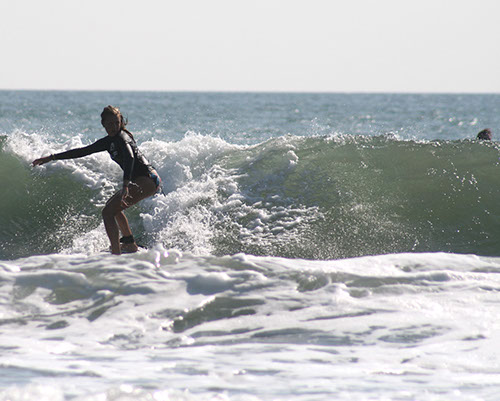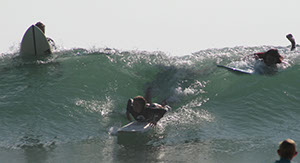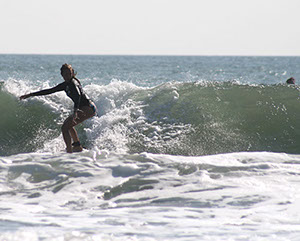SciGen Teacher Dashboard
Unit E4
Making Waves
Scene: Surf's Up (and Down, and Up Again)
Duration: Approximately 50 minutes
 In this Science Scene, a dialogue to read aloud as a class, students play the roles of three friends: Shani, Journey, and Luisa, who ponder ocean waves while watching their friend Georgia as she surfs.
In this Science Scene, a dialogue to read aloud as a class, students play the roles of three friends: Shani, Journey, and Luisa, who ponder ocean waves while watching their friend Georgia as she surfs.
LEARNING OBJECTIVES
Students are introduced to the Focus Words, scientific language used throughout this unit.
Students demonstrate careful reading by identifying accurate details.
Students consider the perspectives of the characters through related questions.
Teacher Tips
- Think ahead about how you will assign the three roles (Shani, Journey, and Luisa) to read the script aloud as a class (or, less ideally, in small groups). Note that students often willingly take on roles regardless of the gender of the characters.
- While it is possible for the students to read the PDF of the script online, we suggest printing the script for the students so they can hold it in their hands and mark it as they read. Consider scaffolding the lesson for English language learners: you could let them preview the script before the lesson or read the dialogue silently once and ask questions to a partner.
- Prior to the reading the script, explain to students that they will encounter new vocabulary terms and ideas that may not be familiar. Reassure them that this lack of familiarity is okay. The reading is meant to introduce the ideas, not explain them completely.
- Review the focus words of the week. The focus word chart linked on the unit overview page should be used as a resource for students to review definitions and sample sentences.
Teacher Tune-ups
Teaching Notes
ACTIVITY OVERVIEW
- Set the context (10 minutes)
- Engage with the script (20 minutes)
- Review the dialogue through writing and discussion (10 minutes)
- Turn & Talk (10 minutes)
Set the context (10 minutes)
Wave behavior is a phenomenon that many students have had personal experience with. Start a pre-reading discussion to explore your students' experiences with waves in the ocean as well as on lakes, bays, rivers, etc. Students are very interested in wave-related phenomena.
Show video. Paraphrase:
How many of you have spent time in waves, swimming, wading, surfing, boarding, sailing? What does it feel like? Where do the waves come from? How do they just keep coming? What kinds of questions do you have about waves?
Paraphrase:
We know that waves happen in the ocean. They make water move. Where else might we observe waves? What other kinds of waves have you heard of?
Today we are going to the beach to look at two kinds of waves and think about what they are.
Engage with the script (20 minutes)
Some teachers have several groups of students read at the same time. Other teachers select a few students to "perform" in front of the class.
These are the Focus Words used in this script and in other activities in this unit and E5:
- wave
- frequency
- amplitude
- trough
- crest
- wavelength
- compression
- medium
Assigning Roles and Reading Aloud:
The three roles are Shani, Journey, and Luisa. Luisa has the most science explanation in her lines.
You may want to read the entire passage out loud to the class once before assigning roles to students or dividing up into groups.
Characters: Shani, Luisa, and Journey
Setting: Shani, Journey, and Luisa are at the beach trying to watch their friend Georgia surf.
 Shani: Can you see her?
Shani: Can you see her?
Journey: Who? Georgia? No, not really. I think she’s out there in that pack of other surfers. Looks like they’re all just sitting on their boards, waiting to catch a wave.
Luisa: You guys know there’s this whole thing about whose turn it is right? It’s called the “lineup.” There’s a place on the wave where it’s the best spot to try to catch the wave. The surfers all stay off to the side and wait their turn to catch a wave. It’s a little more complicated than that, but that’s the general idea.

Shani: There she is! I see Georgia! Oh wait, now I don’t anymore. (pause) There she is again! She’s kind of just going up and down. All the surfers are–just sort of bobbing up and down. Georgia's got the green board. Do you guys see her?
Journey: I see her now. She’s still just sitting on her board. When will it be her turn, already?
Luisa: That depends on the frequency of the waves.
Journey: You mean like how often they’re coming?
Luisa: Yeah, pretty much. Some days it might be high frequency–just one wave right after the other. Other days, you might be waiting longer between waves. That would be lower frequency, and on those days surfers get real snippy about whose turn it is ‘cause there aren’t as many good waves to catch.
Shani: Why is Georgia just bobbing up and down? Why don’t the waves push her towards us on the shore? She’s just going up and down. Look there she is again!
Journey: I’m sure Luisa knows. She seems to know a lot about waves! (eye roll)
Luisa: So those surfers are just bobbing up and down because of the wave's energy. How far Georgia rises up with the crest of a wave or how far she drops down in its trough is the waves' amplitude. Oh, and how far it is from one crest to the next, or from one trough to the next, is called the wavelength.
Shani: OK I think I get that, but then what does my dad mean when he says I'm on my own wavelength?
Journey: Um... well we're not on his—or yours—so how should we know?
Luisa: (refocusing conversation) Anyway... the waves we're watching are all energy. They look like they are made of water, but they're not, not really! They just move through water. Water is the medium.
Journey: Medium water? It looks like extra large water to me.
Luisa: Not that kind of medium! I mean something energy can move through. Energy can move through anything: air, or land, or a wire... lots of different stuff. But here the medium is water.
Shani: I get it! The waves are using their energy to bring in water from way out in the ocean...
Luisa: Nope! Really the water here near the shore is just going up and down, and maybe a little back and forth.
Journey: Hmm. So when I say I see a wave, I'm really just seeing energy traveling? And the water isn't going anywhere?
Luisa: It's moving a little, but hardly at all compared to the wave energy.
Journey: Compared to wave what? I can't hear you. The waves have gotten a lot bigger!
 Shani: Hold on: it's Georgia's turn!
Shani: Hold on: it's Georgia's turn!
The friends shout as Georgia tears through a perfect, large swell, but they can barely hear each others' voices in the noise of the pounding waves and howling wind. They take shelter from the wind next to a beach hut.
Journey: What were we talking about? Oh right, sound!
 Shani: I thought we were talking about waves.
Shani: I thought we were talking about waves.
Journey: Same, same! Luisa says energy travels through water in waves, and I know it does that with sound too. I can tell you all about it. Audio is my thing. Sound waves are basically little air compressions in a pattern that travel out and then get picked up by our ears.
Shani: Sounds about right to me.
Luisa: Your dad might say we're all on the same wavelength now!
Review the dialogue through writing and discussion (10 minutes)
Paraphrase:
Let's review some of the things the friends discussed when talking about waves.
Possible answers:
- At a high frequency, the waves come one after another, more often than they do with a low frequency.
- The amplitude is how far the surfers rise up with the crest of the waves or how far they drop down in the trough of the waves.
- You can measure a wavelength from trough to trough or crest to crest.
- Some examples of a medium that waves can travel through are air, land, a wire, or water.
- Sound waves and ocean waves both transmit energy through a medium. In this scene, sound waves transmit energy through air and ocean waves transmit energy through the medium of water.
Turn & Talk (10 minutes)
Before the third question, paraphrase:
When you hear a sound, what you actually hear is a vibration, or sound wave, which travels through the air to your ear. Whether the sound is coming from a voice, a speaker, or an instrument, something has to vibrate and compress the air molecules around it. The compression of those air molecules creates a wave: molecules bump into each other all the way from the sound-maker to your ear! The flaps on the ears serve a purpose. Their shape assists in catching energy from sound waves all around you.
 DISCUSSION
DISCUSSION
Shani says, "There she is! I see Georgia! Oh wait, now I don’t anymore. (pause) There she is again! She’s kinda just going up and down. All the surfers are–just sort of bobbing up and down."
How would you explain why the surfers are in and out of view from the beach? Use a sketch if it helps you explain.
During the "lineup," Georgia and the other surfers were waiting their turns in the water just bobbing up and down with their boards.
Why weren't the surfers getting pushed toward the shore by the waves? Why did Georgia go in and out of the view of her friends watching from the shore?
Try cupping your ears with your hands to see if you notice an increase the sound energy you are receiving. Your partner can help by talking to you while you test.
Based on the description above of how sound waves work, why did it get harder for Journey to hear the others' voices when it got windy?
BETA Version - Please send comments and corrections to info@serpinstitute.org